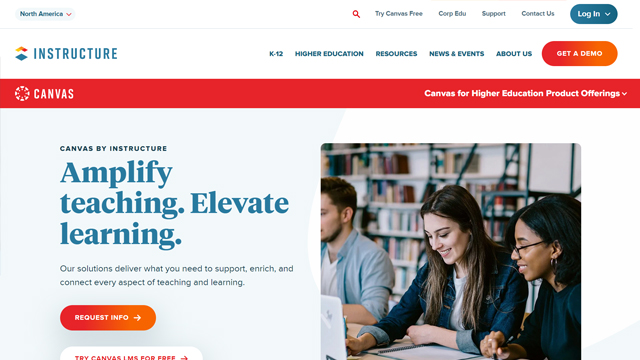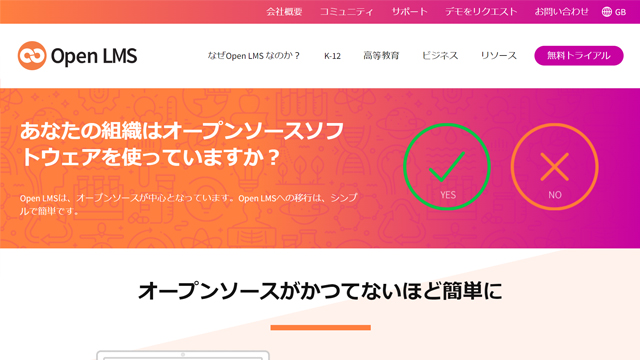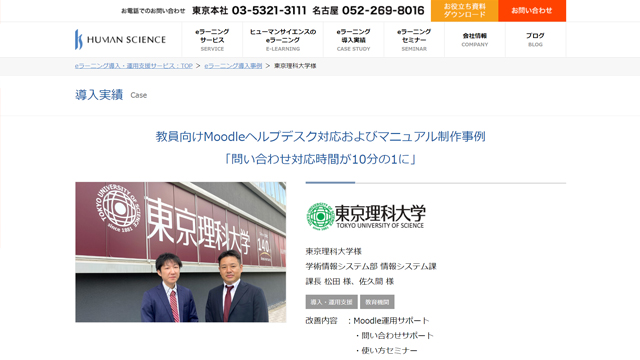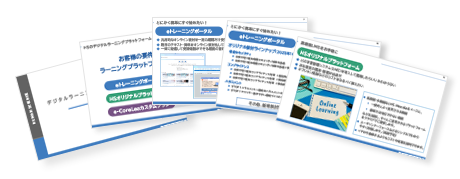2022.06.24
e-Learning and LMS (Learning Management System) Comparison: 4 Key Points
Table of Contents
1. What is an effective LMS (Learning Management System) for e-learning?
1-1. What is e-learning?
1-2. Pros and cons of e-learning
1-3. Can corporate education be done only with e-learning?
1-4. Basic functions of LMS
2. 4 selection points for LMS
2-1. Is it provided as a cloud or on-premises?
2-2. Availability of operational support
2-3. Price
2-4. Flexibility of customization
3. 3 LMS comparisons
3-1. Moodle
3-2. CanvasLMS
3-3. OpenLMS
4. LMS implementation case studies
4-1. Tokyo University of Science implementation case study ~Reducing inquiry response time by 1/10 with Moodle Help Desk~
4-2. Mito Electronic Technical School implementation case study ~Realizing online classes with Moodle, enabling class delivery even during school closures~
1. What is an effective LMS (Learning Management System) for e-learning?

1-1. What is e-learning?
First of all, what kind of means do you imagine when you hear e-learning?
・Viewing materials provided through an e-learning system
・Watching videos on video sharing sites or websites
・Solving problems with a dedicated learning app
・Remote classes through web conferencing tools may be a little different?
There may be many other images as well.
They all become e-learning. E-learning has many meanings depending on the context, but broadly speaking, it refers to the general term for educational systems that utilize IT technology centered around personal computers and the internet.
And there are various means, but there are also a wide range of contents that can be learned through e-learning.
Broadly speaking, they are classified into three categories: knowledge-based, skill-based, and attitude-based.
・Knowledge-based: compliance, information security, etc.
・Skill-based: machine operation technology, software operation technology, customer service technology, etc.
・Attitude-based: business manners, diversity, environmental education, etc.
(things that appeal to consciousness, mind, and impression)
It is necessary to carefully plan the expression methods and delivery methods for each classification.
Until now, "technical skills" were limited to acquiring knowledge for action (+ prompting action), but with the development of the latest technologies such as VR/AR/MR, it is becoming possible to acquire "practical skills" through simulated experiences.
1-2. Pros and Cons of e-Learning
I understand what e-learning is, but what are the actual advantages and disadvantages? Here, I would like to present a comparison with the traditional learning method of face-to-face group training.
Benefits:
●For learners
・Learning achievements are properly communicated to the company: e-learning is usually delivered and taken through an LMS (Learning Management System), and individual learning records are typically stored on the server. As a result, administrators can access this data at any time and evaluate individuals' attitudes towards learning.
・Learn at your own pace, anytime, anywhere: Unlike scheduled group training, e-learning allows you to learn anytime, anywhere as long as you have a device and internet connection. The freedom to learn at your own pace without any constraints is a major advantage. The ease of learning also leads to the habit of learning.
・Unlimited Review: Group training ends once the time is up. Even if you have the text with you, the opportunity to be taught is only once. On the other hand, e-learning allows for repeated learning, so you can thoroughly review and repeat until you understand.
●Administrator Side
・Can deliver homogeneous education to a large number of learners: In group training, the number of participants per session is limited. Also, using the same text may result in variations in quality depending on the instructor. With eLearning, for example, the same educational content can be delivered to 10,000 learners.
・Lower Cost Compared to Group Training: According to calculations done by AUTOBACS SEVEN CO., LTD., a pioneer in introducing e-learning, if the company were to conduct their educational programs using group training instead of e-learning, the cost would be four times higher.
・Easy to add originality to education policies: It is best for a company's talent development plan to be designed based on its own challenges. Of course, it is possible to develop original group training for the company, but in general, it will be based on programs by expert instructors.
The methods for procuring e-learning materials are diverse, including: ① purchasing ready-made products, ② ordering custom-made products, ③ customizing ready-made products, and ④ producing in-house (often referred to as "in-house production"). By combining these options, it is possible to pursue the most ideal educational measures for addressing the challenges of talent development within the company.
Cons:
●Learner's side
・Difficult to maintain motivation
This may vary depending on the individual's personality, but many people enjoy the lively atmosphere of group training. No matter how busy they are, they take a break from work and learn together with everyone. In this case, if the motivation for training is based on this contrast, e-learning may not be enough and may not lead to motivation.
・Environment and device required for taking the course
While you can take in-person training with just yourself, an internet environment and device are necessary for e-learning. In the past, this was often a problem, but now the provision of personal computers by companies has become common, and many companies allow the use of personal tablets and smartphones for e-learning with their security measures in place.
1-3. Can corporate education be done only with e-learning?
What is e-learning? We have written about its merits and demerits, but ultimately, can corporate education be done solely through e-learning? This may raise some doubts.
It is possible to provide a learning environment in various forms such as posting lecture videos on video sharing sites, conducting lectures with web conferencing tools, and storing manuals in a cloud environment, as shown in the previous example.
However, in corporate education, it is essential to strategically manage a variety of means and learning content as outlined below in order to support the achievement of company goals or individual goals.
・Visualize and evaluate each individual's learning status and utilize it for business
・Deliver materials only to those who want them at the appropriate timing
・Implement multiple materials in a planned manner by organizing them into courses
・Maintain motivation for learning continuously
LMS (Learning Management System) is available to achieve these goals.
1-4. Basic Functions of LMS
LMS stands for Learning Management System, and is translated as "学習管理システム" in Japanese.
LMS is a system that centrally manages information such as learners, materials, progress, and grades necessary for e-learning.
※In recent years, not only simple management, but also systems that can be operated as a Learning Experience Platform (LXP) that integrates employee performance management and provides learning experiences tailored to each employee have increased.
> [Moodle Basic Course] What is Moodle?
<Functions for Learners>
・e-Learning Delivery: "Specific Materials" can be delivered to "Designated Learners" for a "Specified Period" and they can be made to take the course. By specifying conditions such as target and date, automatic delivery settings can be used to deliver course information or important company information. There are various functions such as security settings that restrict learning to within the company's internal network when taking lectures that handle important information.
- Submission of assignments, tests, and surveys: It is possible to collectively implement and manage pre- and post-lecture submissions.
・Group Training Management: Not only can participants easily check the content and apply to participate on the system, but they can also conduct surveys in advance, attach materials, and centrally manage traditional tasks.
<Administration Department Functions>
・Organization Management: Set up a corporate organizational chart within LMS to easily extract target individuals from departments and divisions.
・Report creation and management: This is a function that allows you to conduct surveys and submit reports on the LMS. After conducting training, it is common to collect surveys and assign report tasks, but aggregating and summarizing them can be time-consuming and can also add unnecessary burden such as reminders to those who have not completed them. With the survey and report function on the LMS, you can automatically distribute surveys at the end of e-learning or training, and manage reports in bulk by submitting them on the LMS.
・Social Function: A communication function, similar to an SNS, that can only be used by employees. Learning is not necessarily a one-way process from the education provider. It can also be considered as learning when both parties deepen their knowledge by sharing their own knowledge or discussing. In recent years, the term "social learning※" has also been gaining attention, and some LMS have the ability to implement it within their system.
※Rather than one-sided education that clarifies and solidifies the roles of the teacher and the learner, this form of learning is characterized by participants teaching and learning interactively through a network. In a corporate setting, each employee shares knowledge with each other within the organization or across organizations, promoting innovation and improving performance.
Reference URL:
Japan e-Learning Consortium (elc.or.jp)
Fundamentals of e-Learning in Corporate Education Part 1 (Introduction) | e-Learning Blog | e-Learning by Human Science (hs-learning.jp)
2. 4 Selection Points for LMS

Have you ever been overwhelmed by the amount of information when looking at product introduction pages and comparison sites when introducing an LMS? And even after comparing and considering a lot of information, do you still have trouble deciding which one is the best and can't make a selection?
When such a situation arises, it may be beneficial to introduce an LMS. Before doing so, it is important to clearly define the purpose and desired outcomes, narrow down the necessary conditions for your company, and proceed with comparisons, reputation checks, and selection. How does that sound?
There are companies that are new to e-learning and companies that are already working on e-learning but want to improve. I think each company has a purpose for introducing LMS.
"There is a difference in knowledge among members, and it is not efficient to work. Is there a way to standardize knowledge and know-how, even if not skills?"
"In recent years, there has been a lot of coming and going of people, and it's easy to get caught up in education. It's an important phase, but if there was an easier way to do it..." strengthening knowledge management like this.
"We want all employees to approach compliance education with a sense of ownership, but the necessary content may vary depending on their position, and it is difficult to continue conducting it due to the current situation of internal coordination. We want to find a solution."
"Compliance values will change significantly with the changing times. Compliance education tends to take up a lot of time to update..." Compliance education like this
"Although we have a certain amount of educational content, our employees are not actively engaged in it. We want to create an environment where they can learn and manage their motivation." This is an example of motivation management.
I think there are various purposes at last.
These purposes are solved by the functions described in [1-4. Basic Functions of LMS].
If so, what points should we compare to select an LMS?
So from here, I would like to touch on the selection points other than functionality.
2-1. What is the delivery method? Cloud or on-premises?
The first point is the delivery method. The delivery method of LMS can be broadly divided into two categories: "on-premises" and "cloud". To put it simply, each one means the following:
On-premises: A method of installing IT resources such as servers within a company or data center, where the user manages and operates them themselves. This is also referred to as "in-house ownership" or "in-house operation".
Cloud: A method of using IT resources provided by a cloud vendor over a network and paying for usage based on the amount used.
The major difference between on-premises and cloud is that the company does not own servers or packaged software. As it is possible to use without owning assets, as of 2022, if you are building a new IT system, it is now common to first consider using cloud services, which is referred to as "cloud first※".
※In the construction and maintenance of information systems, this way of thinking is further advanced, and a policy has been announced to make the use of cloud services the "first choice (default)". This policy is called the "Cloud by Default Principle".
Reference MaterialsBasic Policy on the Use of Cloud Services in Government Information Systems
So here, we would like to take a look at the advantages and disadvantages of the cloud compared to on-premises.
<Benefits>
・Low initial cost
・Costs can be kept low as charges are only incurred for usage
・Charges will stop if the service is stopped
・Can be used immediately without any hassle
・Data is protected and can be used even during disasters
・Cloud service providers ensure server security, reducing security risks compared to self-operation
<Disadvantages>
・Continuous operation costs and lack of cloud operation personnel
・Limitations on customization
・Some services may not be able to be integrated (such as our own legacy systems)
・If the partnered service is affected during a disaster or emergency, the service may stop ・As it is a service provided by another company, we cannot control the security standards ourselves
Please note that this is a general statement commonly made when introducing a system, so please confirm with your cloud vendor depending on the service contract.
> Benefits and Considerations of Moodle Cloud Services
> Increasing Demand for Cloud Services in e-Learning Systems (Moodle, Totara)
> Moodle Cloud Services (e-CoreLea)
2-2. Availability of Operational Support

It is important to choose a vendor that will provide support not only during the implementation, but also for ongoing operations. Regardless of whether it is paid or free, it is recommended to choose a vendor that offers services such as maintenance, help desk, and outsourcing of operational tasks after the implementation.
> Moodle Implementation, Seminars, and Manuals
> Moodle Maintenance and Operation
2-3. Fees
Finally, let's touch upon the price. Unless you are looking for an extremely low cost, it is best not to rely too much on price information at this point. This is because in many cases, the cost of an LMS is divided into "initial costs" and "monthly usage fees", and the latter, which can vary every month depending on usage, cannot be estimated without narrowing down the requirements. Moreover, the way and availability of listing on comparison sites also varies depending on the vendor, making it impossible to compare under the same conditions. Additionally, the price can also be negotiated. If you make the price a condition from the beginning, you may miss out on an LMS that is suitable for your company.
Instead, it is more efficient to first narrow down the vendors that meet the necessary conditions for our own employee development, and then request information and rough estimates.
2-4. Flexibility of customization
Recently, there has been an increase in companies that prioritize cost and speed and create their own e-learning content in-house. In response to this, various LMS vendors are providing features for creating content or offering in-house support tools. If you want to create your own content, it would be beneficial to include these factors in your screening criteria. By establishing a system for creating content in-house, the flexibility of educational strategies will greatly increase and can lead to significant cost savings in the future. We highly recommend considering this option.
> What is Knowledge Management?
> 3 Reasons Why Education is Important for Compliance Measures and Effective Methods
3. LMS Comparison Top 3
Now, we have learned about general LMS, so from here on, we would like to compare actual LMS as an example.
There are many LMS options, but if you want to keep initial costs down and maintain your company's training style, we recommend open source types.
If it is open source, basic functions can be used for free, so initial costs can be reduced. In addition, templates can be freely built to match the company's training style and management system, making it possible to build the most suitable e-learning system for the company.
3-1.Moodle

<Features>
Moodle is an open-source e-learning system with over 250 million users from educational institutions and companies combined.
One of the main features is its high level of customization. It is possible to flexibly customize each course according to its specific purpose and needs, making it suitable for classes of any size, from small to large.
In addition, it is equipped with a highly versatile editor, making it easy to insert images and videos, allowing for easy creation of teaching materials. Furthermore, it is compatible with smartphones and tablets, allowing students to comfortably attend lectures anytime, anywhere.
<Features>
・Smartphone and tablet compatibility
・Calendar function
・Confirmation of learning progress
・Customization options such as logo and color
・Multilingual support
・User permission restrictions
・Regular security updates
・Course and student group management
・Grade management
・Evaluation function using rubrics
> [Moodle Basic Course] What can Moodle, the e-learning management system, do?
> [Moodle Basic Course] What is Moodle?
> [Moodle Basic Course] Moodle Security Measures
> [Moodle Basic Course] What can be done with Moodle's default features?
3-2.CanvasLMS
 Image Source: INSTRUCTURE
Image Source: INSTRUCTURE
<Features>
The operation screen of Canvas LMS is designed with a simple interface that anyone can use without getting lost. Since it is a foreign product, the translation of the screen may be a concern, but most of the Japanese is translated to a level where the meaning can be understood, so you can rest assured.
In addition, user information and participant information such as course enrollment can be imported in CSV format, allowing for smooth migration from the current system. It also has excellent integration capabilities with other systems. By integrating with the webinar system (BigBlue Button), it is also possible to hold webinars within the system.
Convenient features such as resume usage, recording function, group chat, and shared memos are available for training in webinars, making it possible to conduct training more efficiently and expect high learning effectiveness.
[Function for Administrators]
・User management for administrators, instructors, and learners
・Partial management authority granted to general users
・CSV import function for each information
【Features for Instructors】
・Creation and review of teaching materials and tests
・Confirmation of attendance status
・Grade management
・Creation of journals
・Course discussions
【Features for Participants】
・Viewing information on courses taken
・Uploading assignments
3-3.OpenLMS
 Image Source: Open LMS
Image Source: Open LMS
<Features>
A cloud-based learning management system (LMS) based on Moodle, the most widely used system in the world. With a sophisticated user interface design that is "easy to read" and "easy to understand", even those who are not familiar with LMS operations can intuitively use it. It is equipped with many convenient functions such as analyzing learning progress and achievements.
・Compliance Tracking
・Course Tracking and Management
・Social Learning
・Learning Paths
・Simultaneous Learning
・Portal Site
・Mobile Learning
・Embedded Course Creation
・Certificates and Licenses
・Group Training
・Asynchronous e-Learning
Reference URL
About Moodle/Benefits/Features | No.1 in Japan: Human Science Co., Ltd. (science.co.jp)
Moodle Association of Japan (moodlejapan.org)
Open LMS: Cloud-based Learning Management System based on Moodle | Assist Micro Co., Ltd. (assistmicro.co.jp)
Canvas LMS (Next Generation World Standard e-Learning System) - Bow Net Systems Co., Ltd. (bownet.co.jp)
4. LMS Implementation Case Studies
Introducing our achievements at Human Science Co., Ltd.
4-1. Introduction Case of Tokyo University of Science ~Reducing Inquiry Response Man-hours by 1/10 with Moodle Help Desk Utilization~

<Introduction Background>
・Due to the COVID-19 pandemic, the format of classes has changed, and especially since the immediate aftermath of the pandemic in 2020, classes have been completely switched to online, with an increase in asynchronous classes using LMS (Moodle) where assignments, materials, videos, etc. can be learned regardless of class time.
・We have been using Moodle since before, but at this timing, we have received a significant increase in inquiries from instructors who are using Moodle for the first time, and the response has been handled by the staff within the university.
However, there were more than 100 inquiries in a month, including basic inquiries, and it became difficult to handle them only within the university.
As a result, we had to search for a company that could provide help desk support, and we found Human Science, a Moodle partner company, on the Moodle website and contacted them for inquiries.
<Selection Reasons>
We contacted three Moodle partner companies, including Human Science Co., Ltd., and compared them.
We selected the partner based on the following reasons, mainly for the niche business of operating and maintaining Moodle.
・The company has a reliable scale.
・They have a track record of dozens of operations and maintenance at universities.
・They also offered a price that met our conditions.
In addition, as part of our strategy to reduce inquiries, we can provide the following services:
・Usage seminars (online training)
・Improvement and translation of manuals (Japanese and English versions)
・Creation of video manuals
・Moodle server setup and performance investigation
These services have become key points for our clients to request, not just for help desk support.
<Introduction Results> When it comes to responding to inquiries, the number of hours per month has decreased from 100 to 10 during busy times, resulting in a significant reduction in workload.
- The content of the class was very detailed and not only answered inquiries, but also included suggestions, which was very good.
・Regarding manuals, in the past there were complaints about them being "difficult to understand" or "difficult to read", but now that they have been improved, those complaints have disappeared.・Originally, Moodle's manual was in PDF format, making it difficult to find information among the vast number of pages. However, after the revision, it was reconstructed using Moodle's book function. As a result, it was improved to be easily viewed online from a browser, making it more user-friendly and reducing complaints from teachers.
・There have been requests for English localization of the Moodle manual for some time now, but we have not been able to properly address it until now. This was our first time providing an English version of the manual, but it was greatly appreciated as it had been a long-standing request.
・Video manuals are also being utilized effectively. It is very effective to have all the necessary content prepared for teachers to view, and it has resulted in a decrease in inquiries.
Click here for more details on Human Science's Moodle implementation support.
> Moodle Implementation and Operation Support Services
> Moodle Implementation, Seminars, and Manuals
> Moodle Maintenance and Operation
4-2. Case Study of Mito Electronic Technical School ~Realizing Online Classes with Moodle, Making it Possible to Provide Classes Even During School Closures~

<Introduction Background>
A state of emergency was declared, and despite the fact that new students had just entered, the situation forced us to close the school. At that time, face-to-face classes were the main method of teaching, but around February when the effects began to appear, we started gathering information about e-learning, which allows for online classes, and contacted your company.
<Selection Reasons>
We considered multiple e-learning systems, but decided on Moodle for the following reasons:
・It is open source and has reasonable implementation costs
・There is a wealth of online manuals available
・It has a high market share in universities
And we also considered multiple companies as partners. The reason we chose Human Science is as follows:
・Excellent response during inquiries
・Provided a plan tailored to the size of our school (up to 200 students)
・Extensive track record in operation and maintenance at universities
<Introduction Results> ・When the situation arises where students are unable to attend school, we make the most use of online learning tools for remote learning. In the event of a school closure, if we were to start preparing and transitioning to online learning from that point, it would inevitably result in a loss of time. However, by already having a hybrid form of regular classes, we are able to smoothly transition to online learning during school closures.
- Classes are still mainly conducted in person, but we are exploring methods such as showing preparatory videos and implementing flipped learning to improve the quality of classes. We are also searching for ways to enhance the quality of classes by exploring things that cannot be done through in-person classes alone.
・Students were able to communicate about classes even outside of class time, which was also good because it allowed for asynchronous communication.
> Moodle Help Desk Support and Manual Creation for Educators
> Realizing Online Classes on Moodle: Providing Classes Even During School Closures
Click here for more details on Human Science's Moodle implementation support
> Moodle Implementation and Operation Support Services
> Moodle Implementation, Seminars, and Manuals
> Moodle Maintenance and Operation
> Moodle Implementation and Operation Support Fees
You can view other case studies of Moodle implementation from this article.
> Moodle Implementation and Operation Support Results
At Human Science, we offer various services to help our customers introduce and operate e-learning. Please feel free to contact us if you have any concerns.
> e-Learning Material Production
> e-Learning Material Translation
> In-house Material Production Support
> Articulate Storyline, Studio Implementation and Creation Support Services
> Microlearning Implementation Support
> Flash to HTML5 Migration and Conversion
> Moodle and Totara Learn (Open Source LMS) Implementation and Operation Support
Contact Form: (https://hs-learning.jp/contact/)
Moodle Related Information
- 2024.04.02
- English Learning Using Moodle and ChatGPT
Latest Blog
- 2024.04.02
- English Learning Using Moodle and ChatGPT












